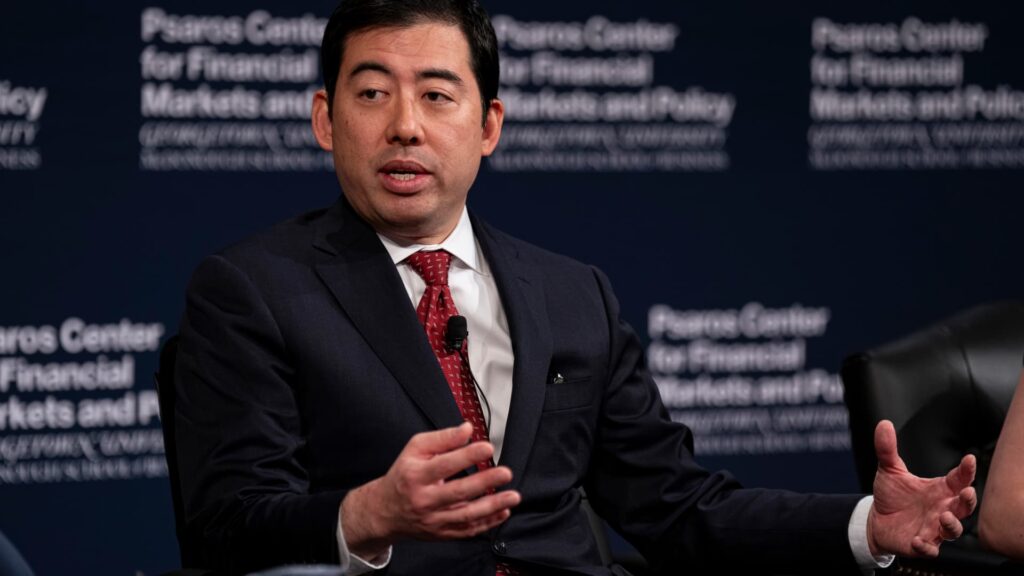Mark Uyeda, commissioner at the US Securities and Exchange Commission (SEC), speaks during the 2024 Financial Markets Quality Conference at Georgetown University in Washington, DC, US, on Tuesday, Sept. 17, 2024.
Al Drago | Bloomberg | Getty Images
The Securities and Exchange Commission is close to allowing dozens of asset managers to blur the lines between exchange traded funds and mutual funds, in a move that would give investors more choice while also raising some potential tax risks.
More than 50 asset managers have petitioned the SEC for exemptive relief in order to offer an ETF share class of an existing mutual fund. Vanguard currently offers this in some cases, operating under a decades-old SEC rule and a now-expired patent, but other asset managers have had to keep strict wall between the two types of funds.
What was seen as a long-term goal for the industry has accelerated in recent months. SEC Commissioner Mark Uyeda said in March that the agency’s staff had been told to prioritize the issue. On March 31, Dimensional Fund Advisors filed an amendment to their application that took into account feedback from SEC staff. Other firms quickly followed up with similar amendments, and at least 45 of the initial 53 filers have since updated their paperwork, according to Morningstar.
“What seems to have happened now is that what we’ve put together is becoming the template for the industry to follow,” Dimensional co-CEO Gerard O’Reilly told CNBC.
What it means for investors
Many ETFs and mutual funds currently offer similar strategies, and in some cases nearly identical investments are offered in both categories of funds from the same firm. There are several key differences between the two, however, including that ETFs can be traded intraday on stock exchanges and typically are more transparent about their holdings.
But perhaps the key difference for investors is the tax treatment.
ETFs are structured so that when one shareholder pulls their money out of a fund, the resulting sale of stocks does not result in capital gains tax for other shareholders, as it often does in mutual funds. One of the SEC’s hesitations in approving these relief applications appears to be concern that co-mingling the funds might result in ETF holders getting hit with an unexpected tax bill.
The risk “is that the ETF shareclass holders are going to end up subsidizing the mutual fund class holders,” said Benjamin Schiffrin, director of securities policy at advocacy group Better Markets. The group is not categorically opposed to the potential changes, Schiffrin added.
The Dimensional amendment includes updated guidelines around oversight of funds that could help navigate issues like tax impact, O’Reilly said. The SEC declined comment.

Regulatory relief would also let money managers put their best mutual fund strategies into the ETF market without having to launch a new fund. That could give investors additional choice and help firms keep customers who have otherwise fled mutual funds altogether, as shown by years of persistent outflows.
Matt Barry, head of capital markets at Touchstone Investments, said financial advisor clients continue gravitating toward ETFs and this change would allow his firm to quickly scale up its nascent ETF business.
“Hopefully it really provides the best of both worlds. It lets the advisors and the investors who like the mutual fund and want to stay there do that,” while allowing others who favor an ETF to “easily switch over without triggering a taxable event there,” Barry said.
The shift could also make it easier for firms to market their ETFs. Current rules mean that long-term track records of a mutual fund are not allowed to be directly referenced when creating a separate ETF version, even if the strategy and portfolio managers are the same.
The same thinking could also work in reverse, if the SEC allows successful ETFs to create mutual fund share classes that fit into 401(k) plans.
What comes next
Getting the legal relief from the SEC would be a multi-step process, explained Brian Murphy, partner at law firm Stradley Ronon. SEC staff members would draft a memo to the commissioners, who would then put approval up for a public notice period. The relief could be granted roughly 25 days after that.
But it will like take even longer before new share classes start sprouting up. The boards that govern individual funds would need to approve the share class changes, and from there it could still be a six- to nine-month process before additional share classes are officially launched, according to O’Reilly at Dimensional.
Part of the reason for the delay is for the firms, fund service providers, brokerage platforms and exchanges to make sure they are all on the same page. Giang Bui, head of U.S. equities and exchange-traded products at Nasdaq, said at a Goldman Sachs event earlier this mnth that exchanges may need to look at tweaking their incentive programs for market makers to ensure there is ample liquidity for a flood of new ETFs.
But given enough time, SEC relief could be a major step in breaking down the barrier between mutual funds and ETFs.
“There’s no reason over the next 10 years that those need to be two separate pots of assets,” O’Reilly said.
